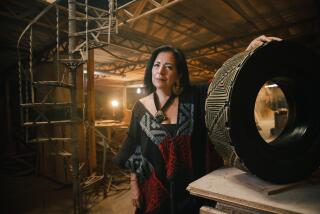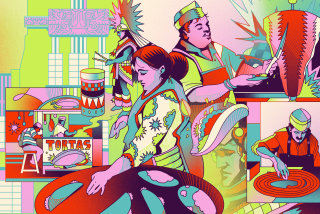LA CIENEGA AREA
- Share via
“Zona Rosa” or “Pink Zone” is the rather ironic name given to the former red-light district of Mexico City that has since become economically rehabilitated as a major tourist attraction, much like New Orleans’ Bourbon Street. In a more generic sense, it is also the very evocative title of Steve Rogers’ latest series of terra-cotta sculptural tableaux, in which the contrast between the demimonde and conspicuous consumption becomes an effective simile for the contradictions of neo-colonialism in the Third World.
Rogers’ admirable facility with narrative tension owes much to his origins as a painter. He manipulates clay as if it were thick impasto; stippled, almost crusty surfaces imbue his muscular figures with a simultaneous sense of stasis and motion that’s compellingly dramatic and stolidly heroic. Until recently, the work had been largely autobiographical, depicting in shallow relief and subdued colors his passion for the beach and boxing, as well as some of the loneliness of his own work process.
The new work, his most assured and resonant to date, is significantly more three-dimensional, employing a broader palette and more defined chiaroscuro (created by higher firing of the underglazing). The rather limiting friezelike format of the past has evolved into a form of social realist theater that is both timeless in its stylistic execution and topical in its political immediacy.
In “Guatemalan Holiday,” for example, tourists take pictures of Mayan ruins, oblivious to the camouflage-clad soldiers firing into the surrounding forest stage left. In “Night Fears,” terrified bourgeois huddle together in the glow of a street light against the encroaching “creatures of the night,” a ragtag, blackened band of guerrillas, serpents and animal-headed murderers. These scenarios throw together both exploiter and exploited, native and foreigner, in a tempestuous melting pot that knows no formal boundaries and few mitigating effects of either culture or technology. The works’ overt theatrical settings and aesthetic allusions to arts and crafts and religious friezes heighten and expand these political antinomies, creating an ideological edge that a mere painting might only suggest. (Rosamund Felsen Gallery, 669 N. La Cienega Blvd., to May 24.)
More to Read
The biggest entertainment stories
Get our big stories about Hollywood, film, television, music, arts, culture and more right in your inbox as soon as they publish.
You may occasionally receive promotional content from the Los Angeles Times.










